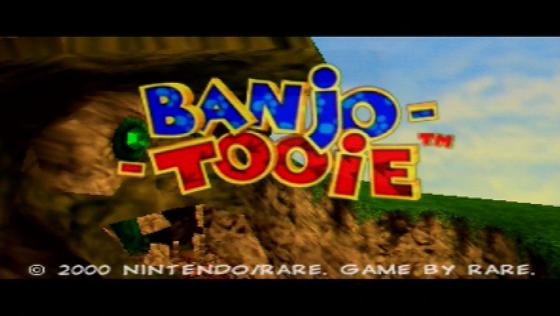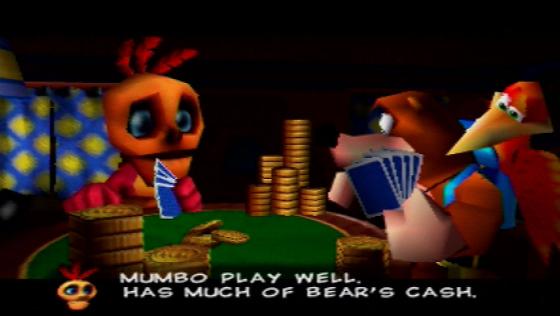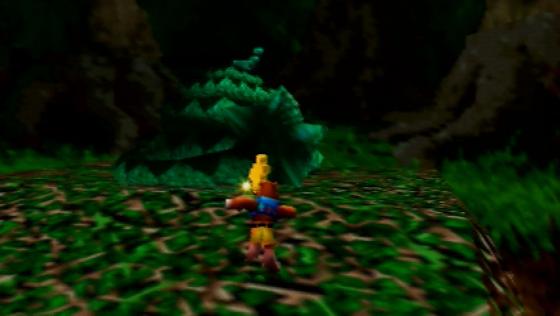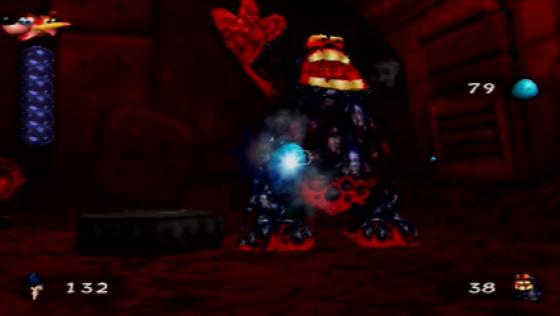
Gaming Age
 13th January 2024
13th January 2024
Author: Craig Majaski
Publisher: Rare
Machine: Nintendo 64 (EU Version)
Banjo-Tooie
Way back in 1996 Nintendo revolutionized the gaming industry with Super Mario 64. Two short years later Rare attempted to one-up Nintendo with their original creation, Banjo-Kazooie. In many people's eyes Rare did just that. Since then, gamers everywhere have been waiting patiently for the sequel to arrive with hopes that it would maintain the high standard set by the first game. Now, two years after the first game was released, Banjo-Tooie sits on store shelves waiting to be bought. And buy it you should.
Banjo-Tooie picks up right where the first game left off. Banjo, Kazooie, Mumbo Jumbo, and Bottles are playing cards inside Banjo's house. Outside, just a few yards away, Mingella and Blobbelda are in the process of setting free their sister, Gruntilda. With the ground shaking so violently from the witches' magical spell, Mumbo goes outside to investigate. Of course, the witches see him and the newly resurrected Grunty starts throwing fireballs at him. He manages to make it back to the house in time to tell everyone to evacuate. Unfortunately, Bottles the mole doesn't believe Mumbo's story and is vaporized in the attack. So another adventure begins for the bear and bird duo.
The game begins in the same training grounds as the first. This time, however, Banjo and Kazooie already have knowledge of all the moves learned in the first game. There are plenty of molehills where the deceased Bottles will explain how to perform the moves just incase you have forgotten or if you haven't played the first game. After you become accustomed to the controls, you'll leave the training grounds and move into the vast hub area. This section of the game is really an expanding level of its own and serves to connect all of the worlds in the game together. The first game had a similar hub inside Grunty's Lair, but that has since been caved in, although you will want to check it out for yourself (hint, hint). The hub is gigantic and harbors just as many secrets as many of the worlds do. As you begin to explore you will be introduced to the supporting cast. Since Bottles is now nothing but a ghost, Sergeant Jamjars, his brother, will now instruct you on new moves. Mumbo Jumbo is the shaman from the first game that used to transform Banjo and Kazooie into different characters. He has since retired from that business and is now playable when his services are needed. To pick up the slack Humba Wumba is gracious enough to do the transformations. Both Mumbo and Humba will require the collection of Glowbos for their services. These little creatures are hidden throughout the levels and provide the magical powers that Mumbo and Humba need to help you.
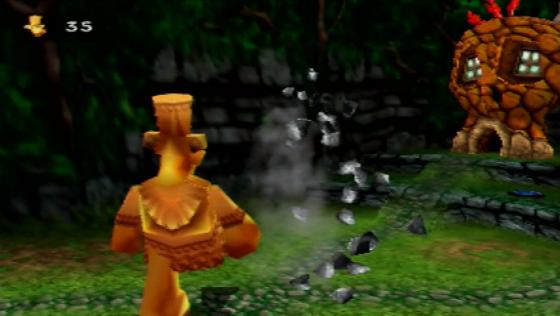
All of the items that could be collected in the previous game are back, but many serve a different purpose. A total of ten Jiggies (they look like puzzle pieces) are scattered throughout each of the 8 worlds. You must collect a prerequisite number of them in order to open the path to the next world. If you recall, musical notes used to serve this purpose. Instead, notes are now found in bunches of 5 or 20 and must be collected in order for Jamjars to teach you new moves. One of the biggest challenges found in Banjo-Kazooie was collecting all 100 notes on each level in one single try. This challenge no longer exists in the sequel, which is a good thing since the levels are so huge this time around. Egg nests and feather nests will continuously rotate through their available stock. Red feathers allow Kazooie to fly, whereas gold feathers provide temporary invincibility. The standard blue eggs are available from the start, but you will eventually acquire other types of eggs, like fire, ice, and grenade (among others). Jinjos, those annoying little creatures that whistle and scream "Help!" are back. This time around there are nine different families (colors) to be rescued. Upon rescuing an entire family you will be rewarded with a prize. There are some new honeycomb energy sections to collect as well as Cheato Pages (collect 5 and a new cheat will be opened).
As I mentioned above, both the hub area and the levels are gigantic. To ease the burden on the player, Rare has provided many methods of travel. In the hub area you will find Jamjar's Silos, which become activated by touching them. These silos will interconnect the different areas of the hub so you'll be able to warp from one place to another in a few seconds. Inside each of the levels you will find warp pads. These serve the same purpose as the silos, except they work only in the level they are found in. In addition, a mysterious train will aid our heroes and will transport them to a variety of locations, sometimes from within a level out to the hub and vice versa. As if all of this wasn't cool enough, as you progress through the game you will become amazed at how many of the different levels interconnect. Some of the quest objectives will actually require you to perform a specific task in one level, which will have a direct impact on another level. For example, in the second world (Glitter Gulch Mine) there is a flying saucer that has lost its way. At the present time you won't be able to do anything to help it out. Once you obtain enough Jiggies to open up the next level (Witchyworld) and begin exploring it, you will come across a button that will open the passage for the U.F.O. to fly through and it will become available to use in Witchyworld. This type of interconnectivity happens often and is a testament to how much thought and hard work Rare has invested when creating the different worlds.
New to the game is the ability to control Banjo and Kazooie as separate characters. Each will learn new moves that only he or she can use. The two can split up whenever they find a split-up pad. This will become essential to solve certain puzzles and it's fun to experiment with each character. In each world you will find Mumbo's Hut and Humba's teepee. You will need to control Mumbo so he can work his voodoo magic. Throughout the level you will find pads that have Mumbo's face on them. They represent places where Mumbo must visit and cast his spell. These spells differ greatly in their uses. In the first level Mumbo's magic will cause a huge golden statue to come to life, and in true Rare fashion you will have total control of that statue for a specified amount of time. In yet another level his magic will cause the sun's rays to oxygenize a huge lagoon so Banjo and Kazooie can breathe underwater. Just as the magic spells are always different depending upon the level, Humba's transformation magic will yield differing results as well. I won't spoil the surprises, but each different form the bear and bird take will introduce new play mechanics for that level.
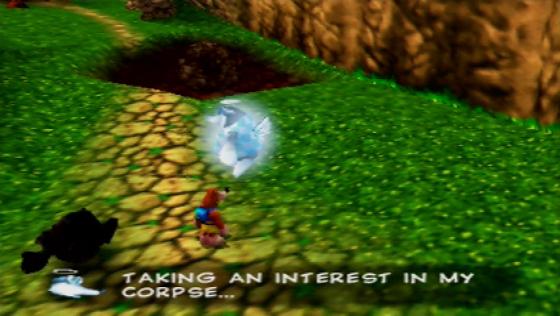
Speaking of play mechanics, I can honestly say that I haven't had this much fun playing a game in a very long time. Not only do the controls harbor the utmost precision, but the camera has been refined as well. In the first game there were many instances where the camera would be stationary upon entering a small room, which would hamper the player's visibility. This has been abolished and now the camera can always be moved around with ease. There are still those instances where the camera will be in the wrong position, but with a simple press of the "R" shoulder button it will swing back to the over-the-shoulder view. Without good controls, even the best looking game can fail. The same can be said about level design. If you thought the levels in Banjo-Kazooie were cool (my favorite was the haunted mansion level) just wait until you play through these. Not only are they bigger, but also each one is filled with exciting puzzles to solve and innovative play mechanics. I can't tell you how many times I was surprised by what the level had to offer. Each one is so different from the others that it keeps the game flowing at a good pace. I never grew tired of any of the levels and every time I would reach a new one I was left in awe. On many occasions I would just look around at all of the fantastic surroundings with a sense of wonderment. Rare has managed to keep each level refreshing and even though your basic goals are the same in each one, the Jiggy collecting never becomes old due to the fantastic puzzles and enticing level design.
The graphics in Banjo-Tooie are vastly improved over its predecessor as well. Many people have complained in the past about the N64's inability to process good textures. I think Banjo-Kazooie was really the first game to feature decent textures that weren't overused or extraordinarily blurry. Rare has done its homework and delivered a game with even better textures that not only look good, but also are vastly different depending on the level. This extraordinary feat is only made more amazing when you consider each level's size and the fact that there is absolutely no fogging in place to hide the pop-up (which there is very little, if any). In addition to the large levels, you will be amazed at some of the enemies, especially the boss characters. Some of them take up more than the entire screen. Even though these gigantic creatures should bring the N64's processor to its knees, the game never once falters. First seen in Diddy Kong Racing, Rare's dynamic lighting makes a return. Many areas in the game will have different colored light sources, which will affect all of the characters that enter that area. In addition, a real-time shadow is now in place for the main characters that will bend and move realistically with the light source. Keep in mind that all of this is done without using the Expansion Pak.
Not all is rosy when it comes to the graphics, however. Due to the vast worlds, the fantastic animation, and the good texturing, the frame rate takes a big hit. The entire game isn't played in slow motion, but at certain times the game will noticeably chug along for a few seconds. Slowdown has been with us since the early NES days, so it's really nothing new. Granted, it isn't seen as much these days, but in my opinion it's not something to get upset over unless it hampers gameplay. If the slowdown was so persistent that it consistently caused me to miss jumps or miss attacks then I'd be upset. Luckily this isn't the case. The slowdown may have an impact on some people, but truly it shouldn't. It has not once detracted from my enjoyment, and I for one would rather put up with the occasional graphical hiccup if the trade off is a game as good as this. It truly shows that Rare has pushed the N64 to its limit. If all you care about are the graphics and frame rate issues, then by all means don't buy this game. If you're concerned about what matters most, the game play and the fun factor, then this shouldn't bother you.
Rare has an uncanny ability to create memorable music on the N64. From the get-go the familiar tunes from the first game are utilized to create a connection between the two games. Of course the music is completely new for the levels, and each one is distinctly appropriate. In the first level the music is filled with ancient chanting to complement the Mayan theme. As you traverse the hub the music will gradually change. When you approach the entrance to the Mayan level the music takes on the same instruments used in that level. It's a subtle, but noteworthy effect that I would like to see repeated in future games. The sound effects are nearly identical to those found in the original game. Once again, due in part to the cart limitations, all of the characters sort of mumble what they're saying as you read along with the text. If you liked the music in the first game, then this is more of the same high quality score.
Banjo-Tooie is the best Rare game to come out since Banjo-Kazooie. It's heads and shoulders above the abysmal Donkey Kong 64 that came out last holiday season. The game is packed with secret areas to discover as well as items from the first game, such as the ice key. Remember the camel from the first game that said he was going to travel to the fire level? He's back, and there's even a fire level to boot. If you have played through Banjo-Kazooie then this game will reward you throughout by making references to that game. In addition the game is packed with the traditional humor that Rare is known for. This is the best N64 game I've played this year, and although I hate to compare the two games, I actually had more fun playing Banjo-Tooie than I did playing Zelda: Majora's Mask. This game will take quite a few hours to complete, and not a single one will be boring. I should also make a passing reference to the multiplayer mode. Up to four players can partake in the mini-games. These vary in execution, from a shootout game ala GoldenEye to a kickball tournament. Each is enjoyable in its own right, but the one player mode is where you will spend most of your game time. You owe it to yourself to play this game. It may be the last great game to come out for the N64. Let's hope Banjo Cubed makes an appearance on Nintendo's next system and that it's just as fun.


